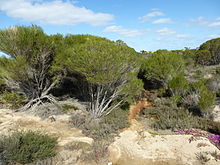Melaleuca eleuterostachya
| Melaleuca eleuterostachya | |
|---|---|

| |
| M. eleuterostachya growing west of Esperance | |
| Scientific classification | |
| Kingdom: | |
| (unranked): | |
| (unranked): | |
| (unranked): | |
| Order: | |
| Family: | |
| Genus: | |
| Species: | M. eleuterostachya
|
| Binomial name | |
| Melaleuca eleuterostachya | |
Melaleuca eleuterostachya is a plant in the myrtle family, Myrtaceae and is endemic to Western Australia and South Australia. It is a shrub or tree with arching branches, narrow leaves and small spikes of cream or white flowers.
Description
Melaleuca eleuterostachya is a shrub or tree with grey papery or fibrous bark, thin arching branches and which grows to a height of about 6 m (20 ft). The leaves are arranged in alternate pairs (decussate), are narrow lance-shaped or narrow oval to linear, about 2.7–14 mm (0.1–0.6 in) long and 0.8–1.8 mm (0.03–0.07 in) wide. They have a hooked leaves but not sharp end.[1][2]
The flowers are cream or white, arranged in short spikes or heads of flowers containing 8 to 20 groups of flowers in threes, the heads up to 20 mm (0.8 in) in diameter. These flowering spikes are on the sides of the main branches and unlike in most other melaleucas, do not continue growing after flowering. The petals are 1.8–2.4 mm (0.07–0.09 in) long and fall off as the flower opens. The stamens are arranged in five bundles around the flower and each bundle contains 12 to 18 stamens. Flowering occurs throughout the year and is followed by fruit which are woody capsules 2.5–4 mm (0.1–0.2 in) long on short lateral branches.[1][2]


Taxonomy and naming
Melaleuca eleuterostachya was first formally described in 1886 by Ferdinand Mueller in Fragmenta Phytographiae Australiae.[3][4] The specific epithet (eleuterostachya) is from the Ancient Greek eleutheros meaning "free"[5] and stachys meaning "a spike",[6] referring to the way the flower spikes appear on the sides of the branches below the leaves.[2]
Distribution and habitat
Melaleuca eleuterostachya occurs in central-southern South Australia and is most common in the Eyre Peninsula. It is widespread in Western Australia, especially the central and southern areas and in a broad band between Geraldton and Albany.[1][2][7] It grows in sandy or clayey soils, on plains, low hills and wet depressions.[8]
Conservation
Melaleuca diosmifolia is listed as "not threatened" by the Government of Western Australia Department of Parks and Wildlife.[7]
References
- ^ a b c Holliday, Ivan (2004). Melaleucas : a field and garden guide (2nd ed.). Frenchs Forest, N.S.W.: Reed New Holland Publishers. pp. 100–101. ISBN 1876334983.
- ^ a b c d Brophy, Joseph J.; Craven, Lyndley A.; Doran, John C. (2013). Melaleucas : their botany, essential oils and uses. Canberra: Australian Centre for International Agricultural Research. p. 152. ISBN 9781922137517.
- ^ "Melaleuca eleuterostachya". APNI. Retrieved 30 March 2015.
- ^ Ferdinand, Mueller (1862). Fragmenta Phytographiae Australiae. Vol. 3. pp. 117–118. Retrieved 30 March 2015.
- ^ Quattrocchi, Umberto (2012). CRC world dictionary of medicinal and poisonous plants : common names, scientific names, eponyms, synonyms, and etymology. Boca Raton, Fla.: CRC. p. 1543. ISBN 9781420080445. Retrieved 30 March 2015.
- ^ Quattrocchi, Umberto (2012). CRC world dictionary of medicinal and poisonous plants : common names, scientific names, eponyms, synonyms, and etymology. Boca Raton, Fla.: CRC. p. 3551. ISBN 9781420080445. Retrieved 30 March 2015.
- ^ a b "Melaleuca eleuterostachya". FloraBase. Western Australian Government Department of Biodiversity, Conservation and Attractions.
- ^ Paczkowska, Grazyna; Chapman, Alex R. (2000). The Western Australian flora : a descriptive catalogue. Perth: Wildflower Society of Western Australia. p. 393. ISBN 0646402439.
